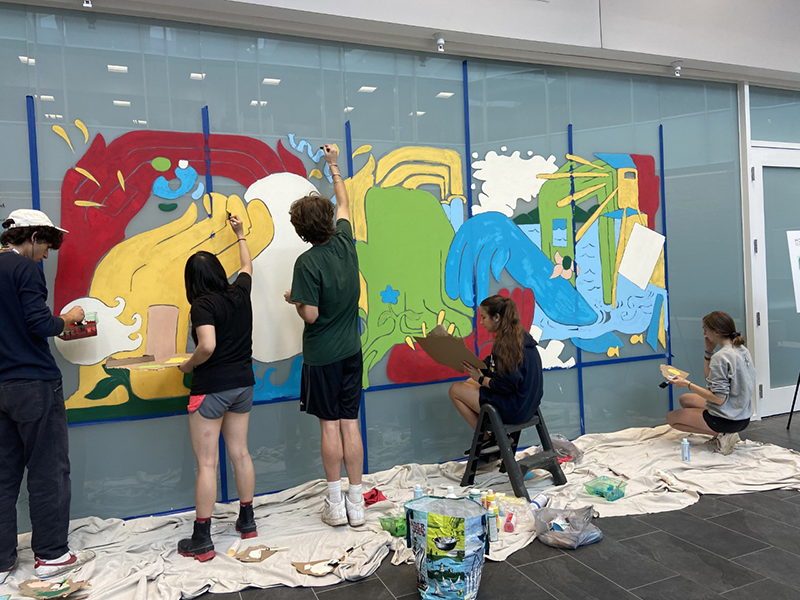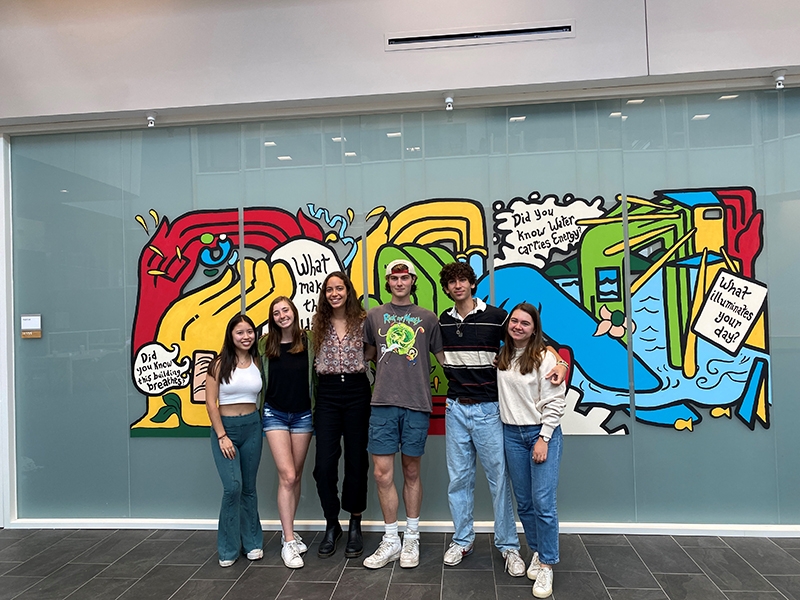The Irving Institute building was designed to be "an energy superstar." Equipped with highly efficient systems that put it on track for LEED platinum certification, the facility occupies the cutting edge of efficiency and sustainability. But while visitors are no doubt struck by the architectural beauty of the space and its abundant natural light, do they understand how exceptional the Institute building is from an energy and sustainability perspective?
Enter the Dartmouth Design Corps. Part of the Thayer School of Engineering's Design Initiative at Dartmouth, the Design Corps program connects student teams with campus clients to put their engineering, design thinking, and liberal arts training to work. Irving Institute Academic Director Amanda Graham and Dartmouth Sustainability Director Rosi Kerr proposed a Design Corps project focused on making these 'invisible' energy and sustainability systems visible to all. Under the supervision of Thayer School of Engineering Associate Professor of Engineering, Eugene Korsunskiy, Kiera Bernet '23, Avery Hormaechea '24, and Sanne Schouten '23, and Annie Qiu '24 (who, while studying abroad during the spring term, collaborated in the discovery process during fall and winter) were off and running.
As the team researched other high-performance buildings for inspiration, said Avery, an Anthropology and Human-Centered Design major, they discovered a common theme : "big, beautiful, interactive installations." To make people pause and take notice of information, they realized, "you need something cool that stands out." An art project emerged as the way forward.
Art as Connector
None of the team members consider themselves artists, but "art felt like a really good way to connect with a broad audience who doesn't necessarily know a lot about energy," explained Kiera, an Anthropology and Human-Centered Design major. "Anyone can connect with the art, and the creation of the art can be a learning experience, a way for people to learn about the energy in the building." They also liked the idea of bringing student artists into the project, which would have the dual benefit of attracting students from different parts of campus to the space.
Initially exploring the idea of a large-scale installation, the team reached out to Dartmouth Studio Arts Professor Soo Sunny Park, who helped the team understand the possibilities and logistics of such an undertaking. After determining that installing a large, site-specific piece was beyond the scope of the project timeline, they settled on the concept of a mural.
Unexpected Results
Now, to find the artists! After distributing a request for proposals via their networks, the Design Corps team didn't know what to expect. "We knew we were asking for a pretty quick turnaround and we were like, man, if we just get one or two that would be great…" explained Avery. They wound up receiving 10 responses.
The group invited the respondents to participate in a design workshop for the project and seven of the 10 showed up. "We showed them around the building, talked about who we are and what our interest is, told them about our research and the building stories we thought were interesting, and did a design sprint to get a sense of themes and aesthetics," Avery said. The team and the artists came out of the initial meeting excited and filled with ideas. After considering multiple locations for the mural, they decided to go with the glass wall of the Project Lab on the first floor of the Irving Institute.
"What Makes this Building Come Alive?"
In their curatorial statement, the team explains that they found four key stories — the natural lighting that reaches 91% of the building's spaces; the natural ventilation facilitated by the glass facade at the entrance; the water-based heating and cooling systems; and the automated windows and shades that regulate temperature — that make the building function like "a living, breathing thing."
The student artist team of Alessa Lewis '22, Camille Lee '22, Ekene Duruaku '22, Harrison Munden '23, Leah Ryu '22, Michelle Chen '22, and Sam Miller '24, took these concepts and ran with them. "During the creation of this mural," explained the students in their artists' statement, "we noticed a consistent theme throughout all the stories that involved the people who contributed to the Irving building. . . . To tell the building's story we depict the many hands that make it work."
The Institute's energy story comes through in the completed mural, with its colorful imagery of hands and air and water and light. Another important element of the building and its place in the newly reinvigorated West End Innovation District also shines through in the piece: this is a site for connection and collaboration, where people with different perspectives and backgrounds can come together to tackle some of the biggest challenges of our time.
The mural is currently on view in the Irving Institute atrium, which is open to the public Monday - Friday, 7 a.m. - 8 p.m.
You can read the full curatorial and artists' statements here.

